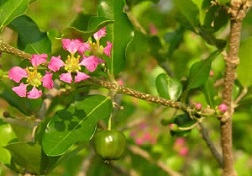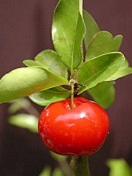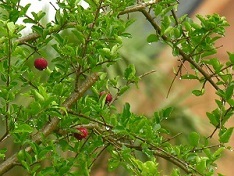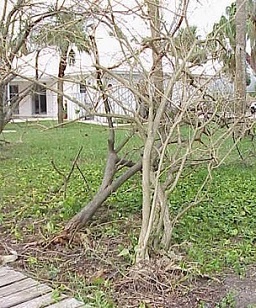Article
from Okeechobee News
by Dan Culbert - Okeechobee County Extension Horticulture Agent, retired
Barbados Cherry - A
Mother's Day Gift That Lasts
This article was originally produced on May 6, 1998 as a bi-monthly
news column for the Vero Beach Press Journal. It has been updated since
its original publication.
Jewelry, cut flowers and an evening
out of the kitchen are traditional gifts for Mother’s day. But
fine jewelry is expensive, cut flowers don’t last, and the dinner
out on the town is just a fleeting moment of pleasure. Mothers like
things that are pretty, and that are appreciated long after the gift is
given. This year, consider a colorful addition to her landscape that is
delicious, nutritious and easy to care for - Barbados Cherry.
Information for today’s column come from the University of
Florida Fact Sheet on this amazing tropical fruit.
The Barbados
Cherry is also known as the Acerola, West Indian or Antilles Cherry. It
is a different plant and unrelated to the Surinam Cherry or Florida
Cherry Hedge that is more commonly planted in our area. To be sure of
what they are talking about, horticulturalists often use the botanical
name to avoid this confusion - so in this case, ask for it as Malpighia
glabra.
This plant is native to the West Indies, Central and
South America, and has been spread beyond its natural range to tropical
and subtropical regions of the world. It traveled from the Lesser
Antilles to Cuba, Jamaica, Puerto Rico and it is believed to have first
been brought to Florida during the late 1880's. During World War II,
the USDA distributed seedling trees for growing in Victory Gardens and
in school yards to increase the vitamin intake of children.
Barbados
cherry received considerable attention in the 1950’s in Florida,
Puerto Rico and Hawaii because of its extremely high vitamin C content.
Approximately 100 acres were established in the late 1950’s in
Florida but this has decreased to less than 25 acres. Acerola, a
popular natural form of Vitamin C, is derived from the Barbados Cherry.
Recent interest in this fruit has stimulated limited new commercial
plantings. However, the Barbados Cherry will continue to be a popular
fruit for the home garden.
Fig. 1. Flowers of Barbados Cherry have a lacy appearance and can be
pale to deep pink in color
Fig.
2. Barbados Cherry fruit are shaped like an apple, but sized like a
cherry. Fruit are highly edible, rich in vitamin C, and contain several
seeds
Fig. 3. The leaves of this plant are elongated and wavy.
Sometimes thorn-like stems may grow from the branches which have many
lenticels
Better selections of Barbados cherry are usually
propagated by air layering or by hardwood cuttings. Sometimes grafted
types are available in specialty nurseries. While this plant can be
grown directly from seed, it will take several years to discover if the
quality of the fruit will be desirable.
Barbados cherry is
fairly tender to cold, especially when young. In our area, choose the
warmest site in your Florida Yard. Mature plants can withstand
temperatures down to 28 degrees F. for short periods without damage.
Young trees should be protected from cold below 30 degrees F.
Acerola
grows well in a wide variety of soils, provided they are well drained
and are not infested with nematodes. Choose sites with good water
drainage, as this plant does not like wet feet. Salt tolerance for this
plant is moderate - it will not do well if planted in ocean-front
breezes or irrigated with brackish water. New plants are best set out
in spring, just before the rainy season. Specimen trees in home
plantings should be allowed at least 15 feet of growing room.
Description
The
Barbados cherry is a large, densely branched shrub. If pruned it will
form a central trunk and can grow as a small tree. It varies in shape
from a low and spreading habit to a more upright and open habit with
slender branches. Shiny light to deep evergreen leaves will vary in
size from 1 to 3 inches and are rounded in shape. The small, attractive
flowers range in color from pale pink to rose. They usually start to
appear in April in our area and flowering will continue throughout the
summer and sometimes into the fall.
Soft, juicy, thin-skinned
Barbados Cherry fruit are light red to deep crimson when mature. The
outer shape somewhat resembles a small apple, but inside the fruit are
several very un-apple like seed. The fully mature fruit average about
an inch in diameter. Barbados cherries are borne in leaf axils, singly
or in clusters of 2 or 3. The shrub may have 3 to 5 crops per year,
from May to November, with the largest crops appearing during the
summer. In frost-free areas it is almost everbearing.
The fruit
is rather tart but some selections are sub-acid to almost sweet.
Inside, the flesh is yellow-orange and very high in vitamin C (ascorbic
acid). The Vitamin C content of one fruit ranges from 1000 to 2000 mg
per 100 grams of edible fully ripe fruit. More acid fruit has higher
vitamin C content, and the amount of this compound is much higher in
partially ripe fruit. Sometimes a single Barbados Cherry fruit can
supply the daily adult requirement of vitamin C.
Barbados cherry
seedlings are quite variable and fruit quality is usually not as
superior as that of improved selections. Seek out the improved clones
such as ‘Florida Sweet’ (introduced in 1956) and
‘B-17’ which has much larger fruit. Commercial producers
may prefer to plant the more acid selections, with higher juice and
vitamin C contents.
Growing
Barbados
Cherries
A
complete fertilizer such as those used on citrus and other fruit trees
should be used. Avoid over-fertilizing since this can result in
excessive vegetative growth and fewer fruit. An adequate supply of
water is beneficial in promoting good growth and maximum yields of
large fruit. It is especially important during blooming and fruit
development.
Fig. 4 
Recent hurricanes had pushed my Barbados
cherry over. Staking, watering and fertilization brought it back into
production. It was 12-15 feet tall going into the storm. The height was
reduced to a more manageable 8 foot height after the storms. (This is
the same plant pictured above, right).
Pruning can be useful in
shaping trees and thinning growth. More bushy selections produce
numerous branches and form thick growth. These can be thinned to
promote heavier yields. In early fall, after the plants have reduced
fruit production, is a good time to prune. Pruning should not extend
into late fall.
Pest
Management
Barbados
Cherries are relatively pest free. The most serious pest effecting this
plant are root-knot nematodes. There are no effective nematicides
available to home gardeners, so the best defense against these
microscopic root feeding worms is to choose healthy plants from
reliable nurseries. Mulch also helps, especially in sandy soils.
Mulching conserves soil moisture, controls weeds and lessens nematode
damage. The mulch may be straw, grass clippings, leaves, wood chips,
sawdust or similar material.
Occasionally, aphids and scale
insects may build up on the Barbados cherry plant. These can be
effectively managed with the use of insecticidal soaps or horticultural
oils. The fruit is attacked by plant bugs which sting the fruit, giving
it a dimpled appearance. This may result in off flavors and reduced
fruit size. There is no practical control for this pest.
Cercospora
leaf spot is the only disease problem on Barbados cherry of much
concern. It occurs with high humidity. The circular, slightly sunken,
dark brown spots occur on leaf surfaces and are larger on young leaves.
Keep the leaves from getting wet from irrigation water. Call your
Extension office if you need help with pest diagnosis or management
suggestions.
Harvesting
and
Using the Fruit
Barbados
cherry will produce fruit the second year after planting and
will be
in good production in the third or fourth. Fruit should be picked
frequently, even if not used, since it does not store on the tree.
Ripe
fruit must be carefully handled to avoid bruising and should be used as
soon as possible or frozen for future use. Half-ripe fruit usually will
hold up well for several days under refrigeration. Barbados cherry can
be eaten fresh and is excellent for juice by itself or in a mixture. It
can also be made into jelly, jam, preserves, puree, pie, sherbet and
wine.
Further
Reading:
Gilman,
E. Malpighia glabra.
(FPS-390) Gainesville: UF/IFAS Extension Service.
11/99 http://hort.ifas.ufl.edu/shrubs/MALGLAA.PDF
Maguire. Ian
Malpighia
glabra
L., Barbados cherry cv. Florida Sweet (Tropical Fruit
Photography Archives). Homestead: UF/IFAS Extension Service, 09/01/02
http://tfphotos.ifas.ufl.edu/090102.htm
Phillips, R.L. & Crane,
J. Barbados Cherry (FC28) Gainesville: UF/IFAS Extension Service, 11/05
http://edis.ifas.ufl.edu/MG041
Other
references:
Dave's Garden Website entry for Barbados Cherry:
http://davesgarden.com/pf/go/57614/
Morton,
J. 1987. Barbados Cherry. p. 204–207. In: Fruits of warm
climates. Julia F. Morton, Miami, FL.
http://www.hort.purdue.edu/newcrop/morton/barbados_cherry.html
Wikpedia entry for Acerola:
http://www.hort.purdue.edu/newcrop/morton/barbados_cherry.html
|
|
Bibliography
Culbert, Daniel F. "Barbados Cherry - A Mother's Gift That
Lasts." Feature Article for Okeechobee News, 10 May 1998, UF/IFAS, Okeechobee County Extension Service, okeechobee.ifas.ufl.edu.
Photographs
Fig. 1,3,4 Culbert, Daniel F. "Barbados Cherry." UF/IFAS, Okeechobee County Extension Service, okeechobee.ifas.ufl.edu. Accessed 26 Mar. 2017.
Fig. 2 Maguire, Ian. "Malpighia glabra
L., Barbados cherry cv.
Florida Sweet." Tropical Fruit Photography Picture Archive, 2002, trec.ifas.ufl.edu. Accessed 26 Mar. 2017.
Published 26 Mar. 2017 LR. Last update 11 Aug. 2018 LR
|




